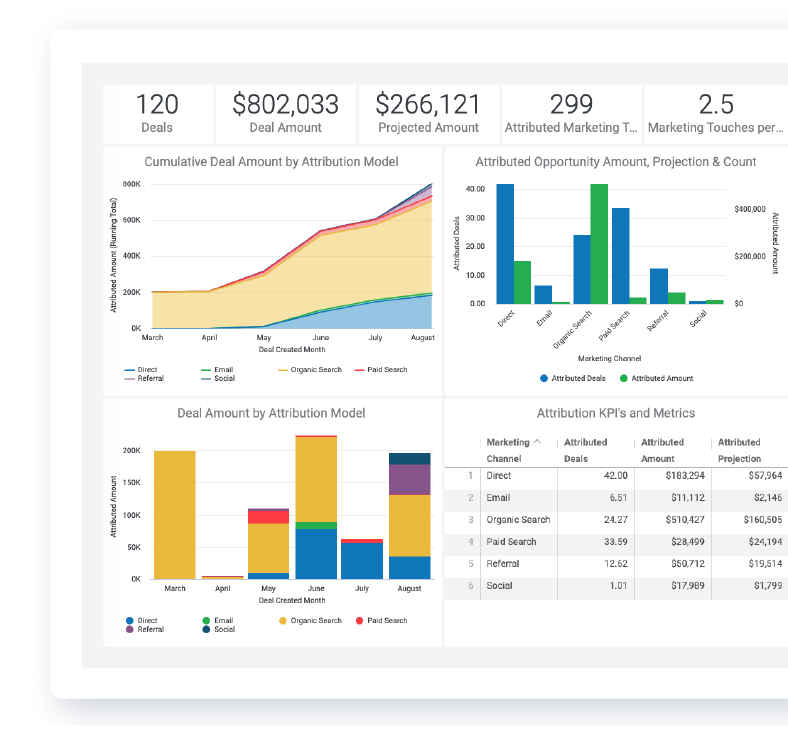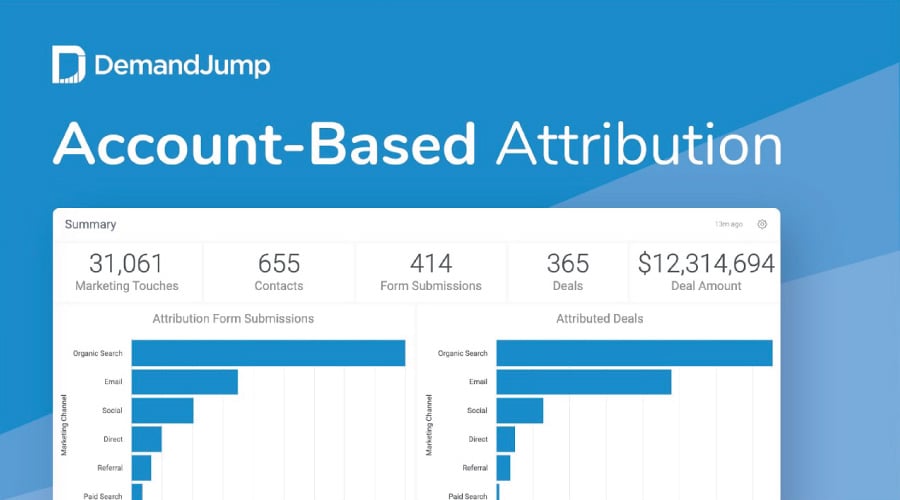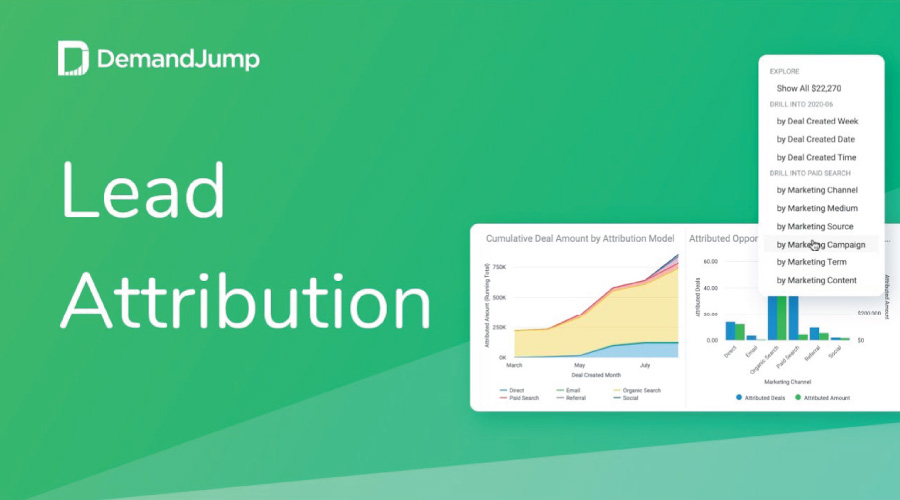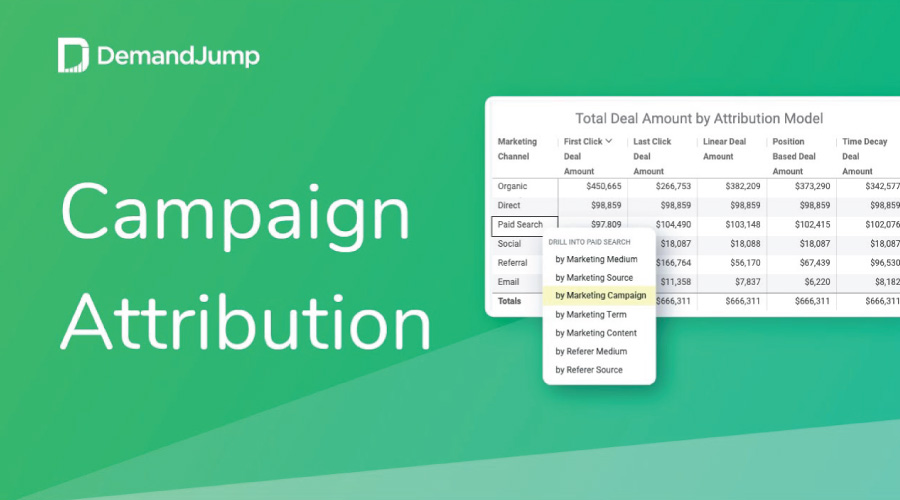Marketing Attribution Videos
By embracing DemandJumps approach to SEO, we have been able to increase our organic rankings within just 2 weeks of implementing recommendations. This helped us see a 22% increase in organic search month-over-month.
Robert Jacko Vice President Digital Marketing @ Homage
DemandJump has become a crucial extension of our marketing team, providing game changing insights to fuel and propel all aspects of our digital marketing efforts. The DemandJump platform is a must have, we are seriously impressed.
Tim Lavinder Director of Ecommerce @ Hotsox
We used to spend hours looking for insights in dozens of tools and reports. Now we log into one place to find out what customers are doing and how to meet them where it matters most.
Zach Roop Digital Marketing Manager @ Dometic
We use DemandJump recommendations as our digital to-do list. We love going in and seeing the recommendations and knowing what to do next.
JoLynda Wilson Marketing Director @ IWC
Our Customers Love Attribution






How do I measure my marketing performance?
Find out which of your marketing efforts are making the biggest impact. See which channel drove consumers to you, the pages they visited, and all touchpoints along their path to purchase.
- Conversion Tracking
- Path to Purchase Model
- Conversion Influence
- CRM Integrations
- Programmatic Impression Tracking
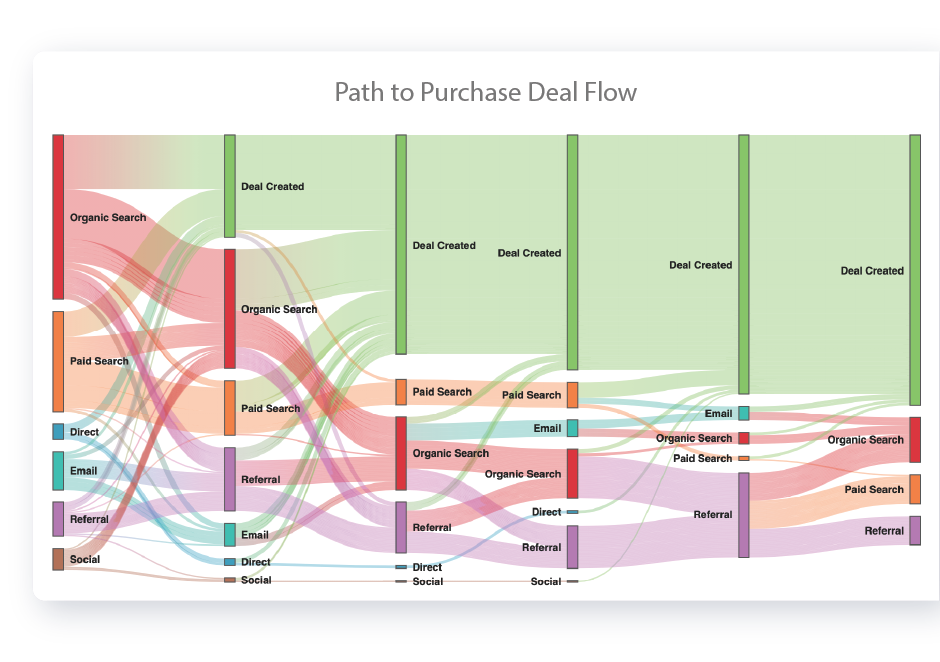
![]()
How do I prove the value of my marketing spend?
When a lead becomes a customer, you need to know which marketing channel, or channels, should receive credit. Accurate account based attribution will get you the most value out of your marketing spend.
- ABM Attribution
- Cross-Channel Attribution
- B2B Lead Attribution
- ROI Tracking Template
How do I choose the right attribution model for my business?
Compare different attribution models side by side so you know how each touchpoint impacts conversions. Now you can shift more of your budget to what’s actually working on your most powerful channels.
- Single-Touch Attribution
- Multi-Touch Attribution
- Algorithmic Attribution
- Media Attribution
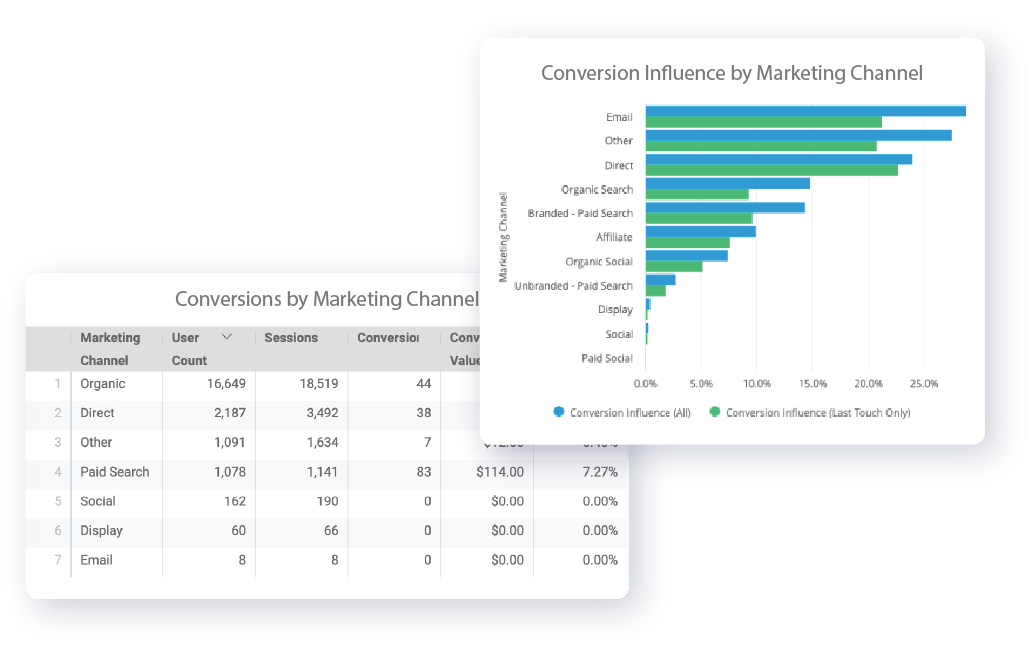
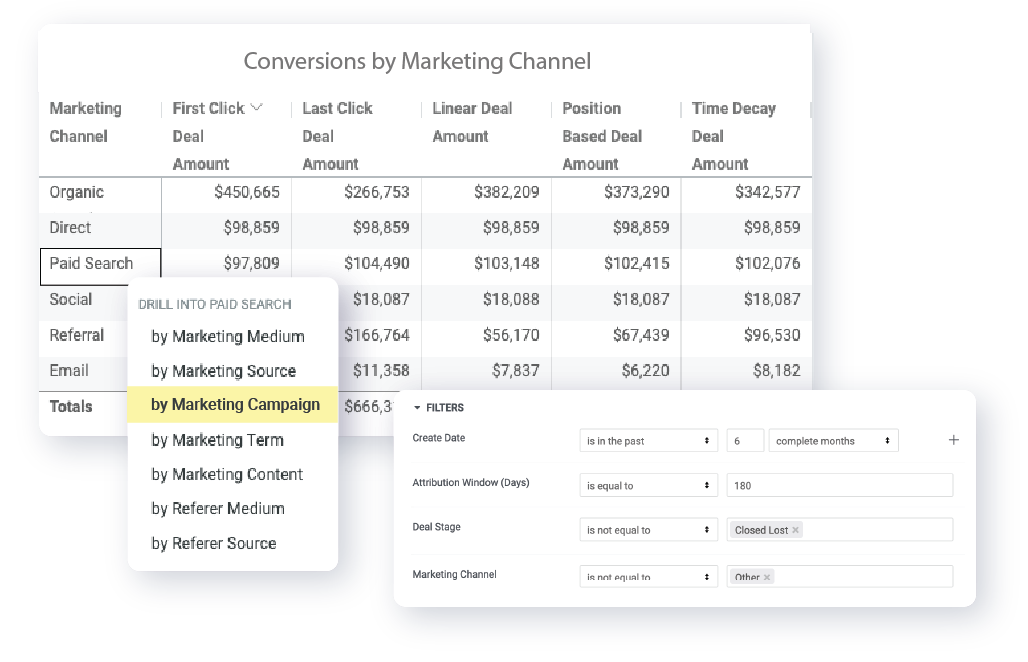
Can I choose the way I view my marketing attribution?
View your marketing data any way you want. This way you can focus on the metrics that will positively impact ROI for your company.
- Custom Channel Grouping
- Customizable Reporting
- Cross-Platform Attribution
- Event Tracking
How do I know what content and keywords drive revenue?
With the CRM integration you will finally see what spend is resulting in actual deal revenue. Get the answers:
- Which campaigns lead to closed won revenue?
- Which pieces of content drive pipeline value?
- What organic search terms drive deal revenue?
- Which paid keywords drive pipeline value?
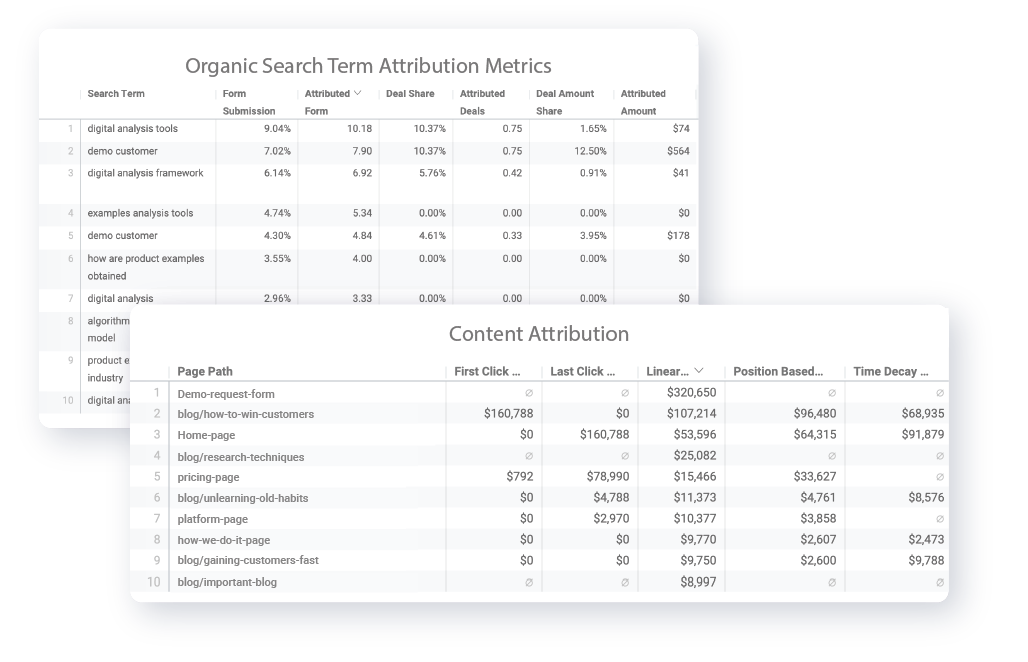
Marketing attribution may seem like a complex and maybe scary topic to address. You may be wondering, what does marketing attribution mean. That’s why in this marketing attribution blog, we will answer all of your marketing attribution questions to help you better understand the topic, develop a few marketing attribution best practices, and use the analysis to move your business forward.
What is marketing attribution?
Looking for a marketing attribution definition? Marketing attribution, sometimes referred to as marketing revenue attribution, is the science of evaluating the impact that marketing touchpoints have on conversions. In other words, marketing attribution helps you find out what efforts are improving your bottom line and how. The difficulty with this topic is largely due to the overabundance of information and the sheer volume of contact points.

Your customer may interact with your brand on a variety of channels. They may also access your brand through third party mentions, print or radio advertising, and word of mouth. Marketing attribution often refers to the analytics which are readily available, such as your conversion rates across marketing channels and campaigns. This is what is known as cross platform attribution (also cross channel attribution). Ideally, the strategy used to collect and analyze information on your customer interaction will be well-rounded and as all-encompassing as possible to fully assess where your brand is on goals and where your message may not be hitting the mark.
What is campaign attribution?
Marketing attribution can be broken down by both channel attribution modeling as well as at the campaign level. At a high level, marketing attribution attributes value to marketing channels, but within those channels, you might also be running several campaigns. Campaign attribution simply refers to the ways that each marketing campaign contributes revenue to your business.
Why use marketing attribution?
To answer the question of what is the purpose of marketing attribution, attribution helps marketers understand what’s working and what’s not, in order to better inform how they invest their marketing dollars in the future.
Marketing Attribution Lookback Windows
Attribution models can typically only retain and process data from a certain date forward - often referred to as a lookback window. This attribution window for email and other channels is typically 30 days. With Google analytics and many other attribution platforms, you can extend it to 90 days.
What is Attribution in Digital Marketing?
When evaluating your marketing attribution strategy, there are several models you can choose from in order to gain valuable insights. One attribution example is a Multi-Touch Attribution. This method looks at all the interactions or touch points your customers have with your brand before converting to a sale or making a purchase. This model is developed to include as much information as possible, which in today's digital landscape may be vast.
The multi-touch example looks to examine all the touch points that lead to a sale. Multi-touch lead attribution is a great way to get a comprehensive view of your marketing efforts. They may weight things, for instance, giving more credit to the last point prior to purchase. That variable is not definitive, though. Consider this marketing attribution example data. We know that customers today often have several interactions with a brand and product before making a decision to purchase. The marketing effort with the highest ROI may not be the last contact point for the customer. Looking at all of the analytics together, you can form a picture of which contact points were common in cases of conversion. You may find a pattern forming in sequence and will often note a higher percentage of interactions for one or two contact points overall.
Another attribution example, though one less commonly used today, is single-touch attribution. This model looks at an individual contact point in the sales funnel. It may weigh the last contact point heavily, for example. This model isn't used as often today because the current research and theories suggest that it's not as accurate and misses important data. It disregards the portions of contact that will often happen prior to a final sale, which are also integral to determining the success of campaigns and the real ROI for your efforts.
When it comes to marketing attribution best practices step one is ensuring your data is accurate. Always QA the data feeding the model to ensure it is correct. Another marketing attribution best practice is to use multiple models. Each model provides insight into a different view of the funnel and it often takes multiple views to ensure you are getting the whole story. More best practices to come.
There are five marketing concepts. These are production concept, product concept, marketing concept, selling concept, and societal marketing concept. Note that each marketing concept example focuses on the customer's needs and wants as a priority. The angle is different for each, but the truth is that customer service has evolved to the point where personalized experience is not only valued but expected.
In these five concepts, you'll see the focus shift from building the production process that offers efficiency and lower pricing for customers to developing the best quality product to ease a pain point for customers, to marketing efforts that directly speak to customers in a personalized way. If you look closely at each of the concepts that the company might be focused on, they all should prioritize the consumer's needs and wants in their development.
What are the different attribution models?
Before we answer what are the types of attribution, it’s important to clarify what we mean by model. So, what is a marketing attribution model? An attribution model refers to the ways that credit is given to marketing touchpoints. Some models giver more credit to the first or last touch along the customer journey. The ways that these attribution systems assign credit depends on how a marketer wants to understand their business. Are you trying to identify which channels are most influential at the bottom of the funnel? Use last click. Interested in understanding the awareness phase efforts? Use first click.
What is first touch attribution?
First touch attribution gives all credit to the first ad or piece of marketing content a consumer engaged with before buying from you or converting on your website. It helps to evaluate your top-of-funnel marketing initiatives.
What is last touch attribution?
Last touch attribution gives all credit to the last ad or piece of marketing content a consumer engaged with before buying from you or converting on your website. It helps to evaluate your bottom-of-funnel marketing initiatives.
What is multi touch attribution?
Multi touch attribution, sometimes referred to as multi source attribution, assigns conversion credit to multiple different sources or channels. It helps to evaluate the customer journey more holistically instead of giving all credit to just one touchpoint to evaluate a segment of the buyer journey. Some models may use a multi touch attribution algorithm to even more accurately evaluate the effectiveness of marketing channels. For example, DemandJump’s algorithmic attribution uses probabilistic graphical models to assess the likelihood of conversion based on which marketing content a consumer has engaged with in what order. Basically, it uses advanced statistics to more finely understand cause and effect.
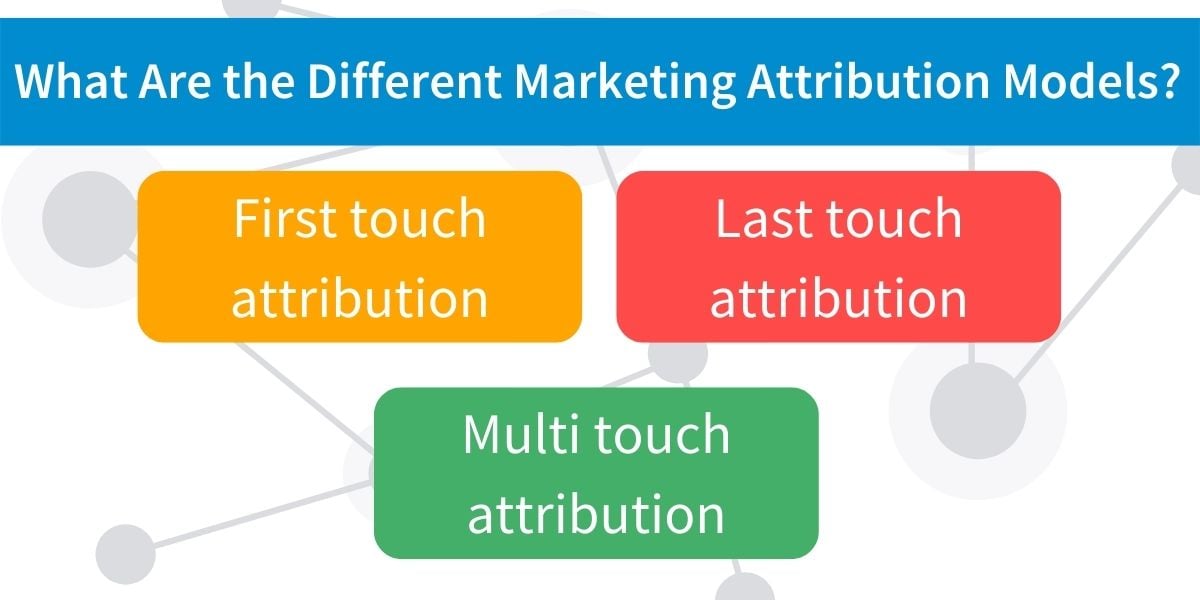
Best Marketing Attribution Models: How do you measure marketing attribution?
As mentioned earlier, how to measure marketing attribution, and determining what attribution model to use, is up to the marketer. It all just depends on how you’re trying to understand the effectiveness of your marketing strategy at each stage of the customer journey. It is often best to utilize multiple attribution models to tell the whole story. The best attribution models to use differ from one company to another based on goals and strategies.
The Value of Marketing Attribution Models
We touched on the marketing attribution models above, but there are numerous options available for both single-touch and multi-touch attribution models. In many cases, you'll use different models to inform parts of your marketing process. This is where you can really benefit from machine learning. Attribution models can be automated using AI and machine learning, taking the burden of data collection and manipulation out of the marketer's hands. You'll also add new models to your process as new technology emerges. For instance, the algorithmic attribution model is fairly new and offers far more comprehensive insights. These models provide much more accurate predictions and forecasts to help determine where your marketing spend should go in terms of ROI.
Marketing budget attribution allows you to shift marketing budget toward channels that are driving revenue. Also referred to as marketing revenue attribution, this ability to accurately attribute closed-won revenue to a marketing campaign allows you to improve the efficiency of your marketing budget down the road.
Types of attribution models might include last-click attribution, which tells you the last point of contact prior to conversion, first-click which informs your information on first contact or new leads, and non-direct attribution which might be any point within the sales funnel. All of these models can be automated using using data integrations and machine learning. Multi-touch attribution might include weighted models or linear models and things like individual devices, which would give you information on the devices your customers are using to find and connect with your brand.
Because so much of your online marketing efforts will involve social media, it's important that you add attribution models to incorporate your analytics from individual platforms. The Facebook attribution tool allows you to examine several attribution models. These include time decay, last click, and positional attribution. The Data Driven attribution model on Facebook uses an algorithmic attribution model to help you establish which campaigns have the best impact, offer the most conversion, and attract the most engagement. All of these measurements offer value when you consider the fact that most consumers will need to interact with your brand several times before purchase. Social media attribution should also be a part of your cross platform attribution solution.
What is an attribution tool?
There are a wide range of attribution tools for marketing that aid in attribution tracking. In short, attribution tools are software platforms that keep track of and analyze the interactions a customer has with your brand before purchasing. A marketing attribution company, or marketing attribution CRM, operates with the goal of stitching together the customer journey so marketers can more efficiently deliver their message to consumers when it matters most. These attribution tools often provide lead attribution tracking out of the box. Many of these solutions, like DemandJump, are designed to offer email marketing attribution as well as analyze all other marketing channels’ effectiveness.
Mobile attribution tools
While your standard attribution tool will handle analyzing mobile advertising effectiveness, many marketers have app downloads they seek to analyze as well. This poses difficulty in the mobile attribution space because most consumer activity goes between multiple platforms to download an app. A consumer often interacts with an ad that drives them to an app store which brings them to a marketer’s app. This requires mobile attribution platforms to gain access to and stitch together data from multiple sources to make sense of the customer journey for the mobile app user.
What is Marketing Attribution Software?
What one person may call a tool, another would call it software. Marketing attribution software connects your disparate data sources in order to automate the attribution modeling process. Let's use DemandJump as an example. A person looking for marketing attribution software would come to DemandJump and create their Free Trial account. Next, the user would connect their different data sources (Google Ads, Facebook, LinkedIn, Hubspot/Salesforce, etc.). Once the data sources are connected, the platform does the rest - creating multiple attribution models in an instant. Now, how do you use these tools to improve marketing performance?
How to Use Marketing Attribution Tools
In order to easily and efficiently collect and analyze data, marketing attribution tools are a necessity. Any attribution app that you might employ should be user-friendly and offer robust reporting options to help you form full overall pictures, as well as more in depth assessments on specific campaigns or areas.
As the marketing attribution software advances, you'll find better ways to sift through the data to form valuable insights. There are so many possible scenarios to the truth behind your data. If you're not using an attribution platform that allows you the best ability to compare and analyze these contact points, the best case projects will likely be faulty.
Your tools are a critical component to using the data at your disposal. Without the right tools, the work that goes into launching campaigns and compiling data is fairly useless. You can only derive so much from manual oversight. The tools allow a better comparison and view of the whole. There are several criteria you should look for in a good marketing attribution software. You need to make sure that it integrates with your current software and platforms. You also want to verify that it will be easy to use and that training materials are easily available. As with any software solution, it's only going to reap results if it's used properly.
Other criteria you want to verify is that the software will allow you to launch robust reporting options to give you advanced oversight.
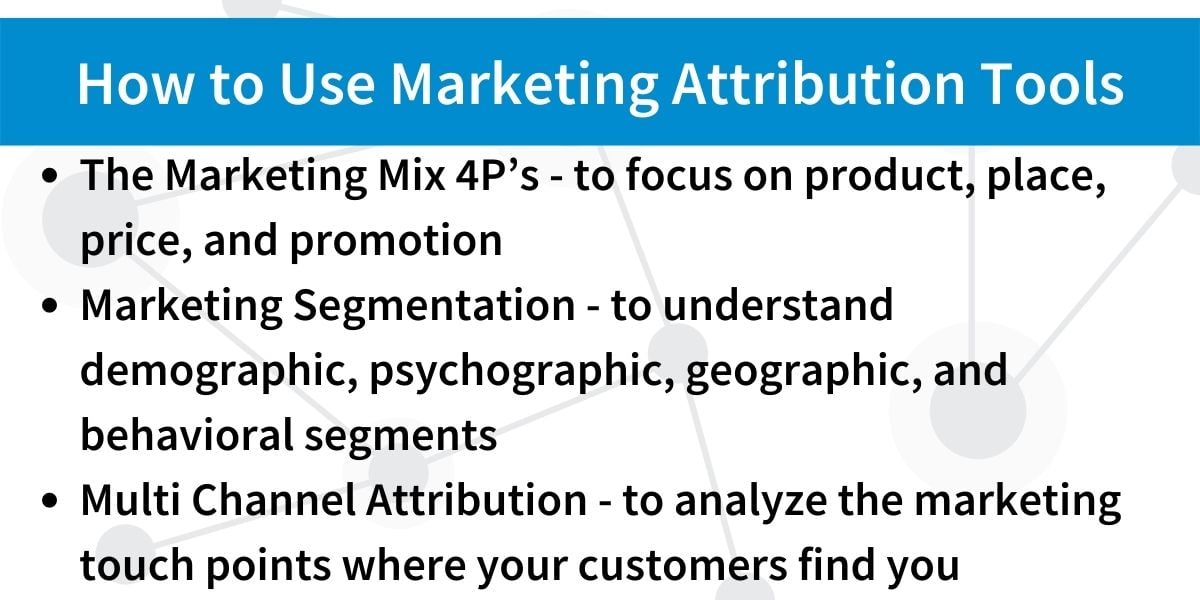
Marketing Mix
The marketing mix is a term used to describe the tools or strategies that you use to reach your marketing goals. You'll often hear this called the Marketing Mix 4P’s. The four Ps refer to product, place, price, and promotion. There are other Ps that can enter into this mix, such as positioning. The original four Ps are integral to developing your marketing positioning.
The elements of marketing mix include all of these 4Ps at the very least. They each help you to crystalize the customer's experience and where your products or service fit in that market. When you look at each of these individual elements, you need to ask questions that will help you clarify what your products do, who they serve, and why your business is the best fit for the customer's needs.
- Products. This P can deal with a specific product or might be more about a service, depending on your business structure. When you analyze this aspect of your marketing, you want to determine what the customer wants when purchasing this product. From there, you need to determine whether or not your product meets those needs and how you can improve the product to better meet them.
- Price. Price questions will often do competitive research but will also assess whether the price may be a pushing asset for the product. In some cases, the price is the major selling point.
- Promotion. This deals with the ways that you're marketing the product. This will speak to the planned marketing campaigns and other pr efforts.
- Place. This specifically discusses where the product is purchased. This might be geographic, online, or via door to door sales. This aspect of planning your marketing mix helps to crystalize your overhead and employee expenditure, as well.
All of these specific elements go together to help you determine the full customer persona and develop the best experience and products for the market. The answers to these questions will help you map your marketing position and determine who your direct competition is, so that you can target the right demographic for your business.
The marketing mix doesn't just inform the way that you market the business. It's the backbone of your entire business plan. These are the basic questions that will makeup your business strategy, as well as informing your customer base.
Marketing Segmentation
In marketing, segmentation is critical today. Once, any form of marketing was just a way to put your message on a loudspeaker. It was one slogan or ad copy that was repeated, verbatim, in different mediums. The same slogan would appear on your packaging, in your office, on print advertising, and any form of commercials. That was many years ago. Since then, we've learned that personalized marketing is far more effective. With the current availability of digital marketing, we can more easily achieve a personalized message. To do that, marketing segmentation is the best tool at your disposal.
There are many market segmentation examples you can use. Your marketing efforts can be directed in a number of ways and, when you look at your audience as a whole, you'll recognize that they can be categorized by many characteristics.
The four types of market segmentation include demographic, psychographic, geographic and behavioral. Demographic segmentation uses information about the customer's age and gender, along with more specific information, such as marital status, income, and education. In the case of B2B marketing, demographic segmentation might include the job title of the contact person and the industry. Though today, many B2B marketers are using B2C segmentation techniques when reaching out to contacts.
The psychographic segmentation includes things like interests, motivations, and things that the customer prioritizes. The geographical segmentation might be wide, such as by country or large regional area or it may be far more exact, such as zip code or school district. Behavioral segmentation often focuses on how the contact person interacts with the brand and their spending habits.
Using segmentation allows you to personalize the message to the individual customer. For example, you would use marketing segmentation in your email campaigns. This might include sending follow-up email to those who have recently purchased items, but separate email to those who left their cart mid-purchase on your website. These would be two tailored messages that only went to the segment of your audience where it was applicable.
You can use the same segmentation techniques on social media platforms, through SMS messaging, and other channels. Your audience receives advertisements that speak to their individual needs at that time which gives you a much better rate of conversion. Ideally you want to meet the customer's needs before they even know they have them. That, at least, is the goal.
Multi Channel Attribution
Multi channel attribution is an amazingly powerful tool. Your customer interacts with your brand in a seemingly endless variety of ways. Consider the fact that most people will use their phones to research things at a whim. Their phones also contain a location device. For your business, this means that if you're using all the tools at your disposal to accurately represent your business and products online, your customer's own devices will promote you when they're geographically close or simply looking for the product you have.
This is why it is so integral to use your marketing efforts to correctly promote who you are and what you do. This is a proactive way to connect every part of the experience for the customer, and for your own marketing team.
Multi channel attribution allows you to collect and analyze the Marketing touch points where your customers find you. In multi touch attribution models, you can see all the ways your customer interacts with your brand. Not only the last contact point or the first, you get every contact point and the duration of time, as well as the time delays.
Multi touch attribution is important because your customer isn't only making decisions based on a single contact. That can happen, more rarely. Customers will be more motivated to buy when they come to your services after researching. Essentially, they were already looking to purchase when they found your solution.
That is not the majority of purchases in most industries. That is a more common model in areas where people only shop when something needs to be replaced or fixed, such as an auto mechanic. For most businesses, though, customers will interact with a brand several times before purchasing. For the marketing team, this gives you ample data to see which campaigns and messaging were most effective.
It's also important to analyze this data to determine whether your branding message stays on target.
Multi touch attribution gives you a way to assess all of these touch points. This includes messaging that the company is putting out but it also includes social media mentions, which can be put out by customers or reviewers. You should be able to follow review pages, print ads, even offline exchanges. This is also where you would gain insight into email marketing attribution. Which emails lead prospects down the funnel and which emails do not contribute to conversions? All questions answered when using a multi touch model.
There is a lot of information held within the buyer's journey. This type of attribution lets you study every step to see where the touch points work well and where they can be improved. It can also be useful to help in retargeting customers who fall out of the funnel prior to conversion. Overall, this attribution model allows you a more in depth look at the individual audience member and your market as a whole.
Custom attribution model
There are a variety of ways marketers may seek to improve their attribution. While the attribution data science and attribution modeling statistics we see today were developed in the digital marketing playground, offline marketing still exists, and marketers still need to understand the value of these efforts. Therefore, the demand for offline marketing attribution methods is increasing. Offline attribution modeling is not as straight forward as online. If you are attempting attribution on your own you may be wondering how to build a marketing attribution model or asking, “how do you develop a marketing attribution model?”. You may even be trying to generate an attribution analysis in excel.
But the hard truth is that offline attribution requires much advanced statistical modeling and sophisticated data science to make sense of. DemandJump offers offline attribution by leveraging the power of AI and machine learning to evaluate the effects of offline marketing activities.
Why Marketing Attribution Is Critical for Your Business
Marketing attribution allows you to classify and study the overall impression that your branding has on the customer and to determine ways that you can improve. Data gathered through these analytics can help you refocus marketing directives. It also becomes useful when developing new products. Your data allows you to gather information from your customers about their needs. This lets you develop the products they want, which gives you a ready-made market for sales.
Marketing attribution is critical today because customers expect a personal experience. They want their needs met immediately. Because technology has advanced to the degree that customers can expect that level of personal, real time service, companies that don't use the latest methods to gain insights will fail to stay competitive with the market.
Marketing attribution is useful for marketing campaigns but it also informs the health of the business as a whole and the way that it functions in the market.
Marketing Attribution Resources
Marketing AttributionAttribution Tracking
B2B Marketing Attribution
Hubspot Attribution
Marketing Campaign Influence
Mobile Attribution
Multi Touch Attribution
Offline Attribution
Sales Forecasting
Sales Opportunity Attribution
The Future of Data-Driven Marketing
Opportunities of Internet Marketing
Other Resources
Channel Optimization
Consumer Behavior
Consumer Insights
Consumer Insights and Analytics
Competitor Analysis Tools
Content Marketing
Content Strategy
Cross-Channel Analytics
Customer Insight Research Techniques
Customer Journey Map
Market Intelligence
Marketing Analytics Techniques
Market Research
Marketing Attribution
Opportunities of Internet Marketing
Types of Consumer Insights


